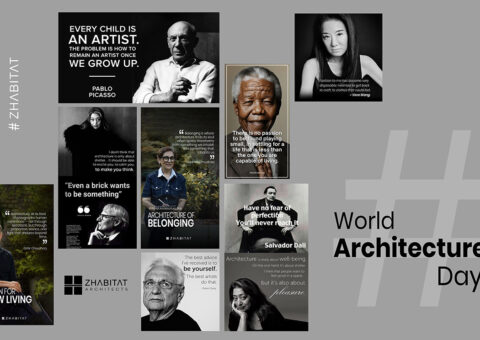Lessons from the Masters

Zafar Choudhary reflects on proportion, permanence and the quiet strength of architecture.
Architecture has always been, for me, a search for balance — between strength and silence, form and emotion, permanence and presence. Every building that stands with conviction carries within it an inheritance of ideas, shaped by those who came before us. On this World Architecture Day, I find myself revisiting the words of the great masters who taught us not just how to build, but how to think — about space, time, and the human condition that anchors both.
Louis Kahn once said, “Every building must have its own soul.” Those words have guided me since my earliest years in practice. To me, a building without soul is geometry without purpose. When proportion and light find alignment, the soul emerges — not as an aesthetic outcome, but as a feeling. Every project we undertake begins with this search: for authenticity, for rhythm, for that quiet moment when a space begins to feel inevitable.
Frank Lloyd Wright wrote, “Buildings, too, are children of Earth and Sun.”
It is a reminder that architecture does not stand apart from its landscape — it grows out of it. I have always believed that buildings must breathe the air of their place. The terrain, the climate, the craft traditions — these are not contexts to adapt to, but collaborators to converse with. The success of a structure is measured not by its scale, but by its coherence with the land it rests upon.
Mies van der Rohe taught us that “God is in the details.”
That truth reveals itself every day on a drawing board. The precision of a joint, the grain of a material, the way light grazes a wall — these are acts of devotion. The discipline of restraint, the humility to refine, the patience to edit — this is where design transforms into architecture.
Zaha Hadid reminded us that “There are 360 degrees, so why stick to one?”
Innovation, for me, is not about rejecting tradition; it’s about expanding it. Each project demands a fresh lens. Geometry becomes an exploration, not an exhibition. The freedom to question and the courage to simplify — that’s where the new finds its place within the timeless.
I.M. Pei said, “Architecture is the very mirror of life.”
And that, perhaps, is the truest statement of all. Every space is a reflection of how we live — how we gather, pause, and remember. The courtyard where families meet, the threshold where they greet, the silence of a study where thought takes form — these are architectural experiences as old as civilization itself.
David Chipperfield wrote, “The difference between good and bad architecture is the time you spend on it.”
Architecture is, at its heart, the art of patience. It requires time to listen, to adjust, to let proportion mature. I’ve often said that the best architecture reveals itself slowly. It’s not designed to impress; it’s designed to endure.
Maya Lin once reflected, “To fly we have to have resistance.”
Those words resonate deeply. Every site, every material constraint, every challenge is a form of resistance — and within that tension lies the possibility of grace. Architecture grows stronger when tested. Resistance refines us; it ensures that beauty is not accidental but earned.
Norman Foster reminded us, “You never stop learning.”
Architecture is a lifelong apprenticeship. Each project teaches humility; each collaboration expands perspective. At Habitat, learning is a continuum — from artisans in stone yards to young designers in our studio, from digital modeling to handmade joinery. That exchange keeps architecture alive and evolving.
Frank Gehry said, “I work from the inside out.”
That is how I’ve always approached design. Space planning is the first act of architecture — the choreography of movement before the costume of form. Every room, every connection, must serve the human experience before it serves the façade.
Richard Rogers once said, “I love my job. What would I retire to?”
That sentiment reflects what architecture truly is — not work, but a way of living. It shapes how you see, how you travel, how you notice light. For me, architecture is both discipline and delight — a lifelong dialogue with proportion, craft, and time.
And then, there is my own quiet belief:
“Strength in architecture is not measured by how long a wall stands — it’s measured by how deeply a home can hold life.”
True strength is never loud. It’s in the steadiness of a space that welcomes change yet remains anchored in meaning. It’s in homes that breathe, civic spaces that gather, and architecture that holds memory as much as light.
As Monika often says, “Perhaps the most human form of architecture is the home — where design forgets its performance and becomes memory.”
That is where the journey of all great architecture ends — not in the drawing, but in the living.
In how a space listens.
In how it remembers.
In how it holds life, quietly, over time.



